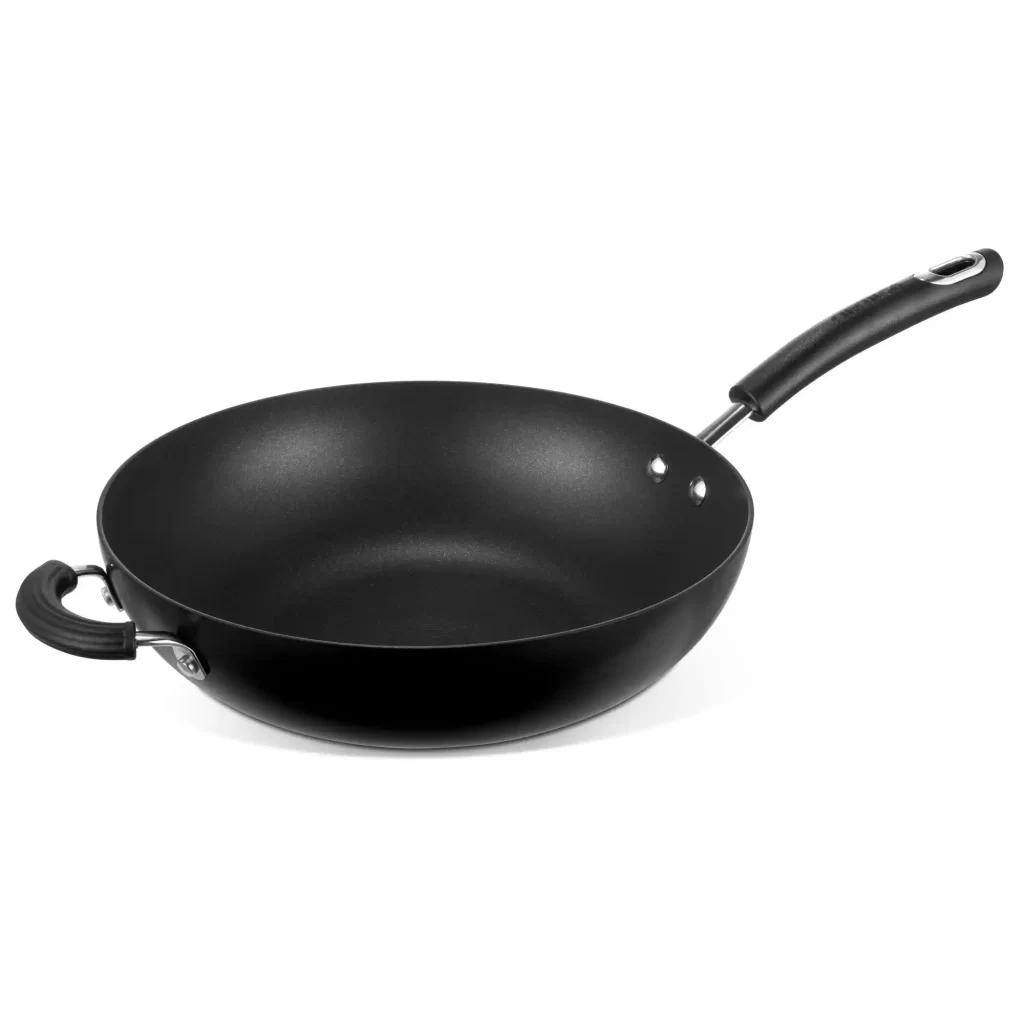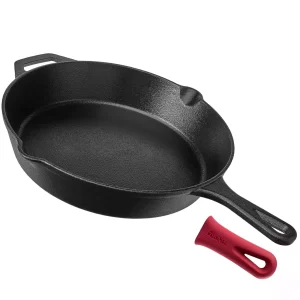Definition of Hard Anodised and Cast Iron
Cast iron and hard anodized are two materials that are commonly used for cookware. The hard anodized cookware is made of aluminum treated by an electrochemical treatment to produce a non-porous, hard surface. The surface is non-reactive and won’t react with acidic food.
Cast iron cookware is created by melting the iron and pouring it into a mold to form a particular shape. Cast iron is heavy, durable, and known for its heat-retention properties. Cast iron cookware can be coated with enamel or seasoned to create a nonstick surface.
Understanding the difference between cast iron and hard anodized is important
It is important to understand the differences between cast iron and hard anodized cookware, as it can affect the quality of the food you cook and the durability of the cookware. Each material has unique benefits and drawbacks that can affect your cooking experience.
Hard anodized cookware, for example, is lightweight and heats quickly. It’s ideal for delicate dishes, or for people who cook with less fat. Cast iron is heavier and heats up slower, but it retains heat very well. It’s great for braising and searing.
Each material also requires a different level of care and maintenance. Cast iron cookware, for example, needs to be seasoned and will rust if it is not cared for properly.
Hard anodized cookware, on the other hand, can be washed in the dishwasher and is resistant to corrosion and scratches. Cast iron and hard anodized cookware are both durable materials that can last for many years.
Hard Anodised Cookware
A hard anodized pan is a cookware type made of aluminum. It has been electrochemically treated to produce a non-porous, hard surface. This is resistant to scratches and abrasions. This surface is non-reactive and won’t react with acidic food.
Hard anodized cookware has many benefits and features:
Lightweight: Hard Anodised Cookware is lighter than Cast Iron, making it easier to handle while cooking.
Even Heating: Hard anodization creates a surface that distributes heat uniformly, ensuring that food is evenly cooked.
Nonstick: Hard anodized cookware is naturally nonstick due to its non-porous surfaces. This means it uses less oil and can be cleaned more easily.
Cookware that is resistant to corrosion and scratches: The cookware has a hard anodized finish, which is highly durable.
Nonreactive: Hard anodized cookware has a nonreactive surface that won’t react with acidic food, affecting the taste and quality.
Examples of hard-anodized cookware are frying pans and saucepans.

There are advantages and disadvantages to making use of hard-anodized cookware.
Pros:
Easy to handle and lightweight
Even heating
Non-stick surface
Durable and long-lasting
Non-reactive
Cons:
It can be costly
Not suitable for cooking at high temperatures
Dishwasher safe or not depends on the instructions given by the manufacturer
If not treated properly, it can warp.
Cast Iron Cookware
Cast iron cookware can be made by melting the iron and pouring it into a mold. Cast iron is heavy, durable, and has excellent heat retention. Cast iron cookware can be coated with enamel or seasoned to create a nonstick surface.
Cast iron cookware has many benefits and characteristics:
Durable: Cast-iron cookware has a reputation for durability.
Cast Iron Retains Heat Well: Because cast iron conducts heat evenly, it retains heat. It is therefore ideal for frying, searing, and braising.
Naturally Non-stick: Cast Iron Cookware can become non-stick naturally over time if it’s seasoned with oil.
Versatile: Cast Iron cookware is suitable for all stovetops including electric, gas, and induction. It can also be used as a grill or on a campfire.
Cast iron cookware includes frying pans and griddles.

Cast iron cookware is a versatile product with many advantages and disadvantages.
Pros:
Durable and long-lasting
Heats well and retains heat
Non-stick Sticks That Are Naturally Non-stick
It is versatile and can be used in all types of stovetops, ovens, or grills
Cons:
Heavily laden and difficult to handle
If not maintained properly, they can rust.
Regular sprinkling is required to maintain a non-stick surface
Heats up slower than other materials
Hard Anodised and Cast Iron in the comparison chart
Hard anodized aluminum and cast iron are two popular materials for cookware, each with its own set of characteristics and advantages.
Here’s a comparison chart to help you understand the differences between the two:
| Characteristic | Hard Anodized Aluminum | Cast Iron |
|---|---|---|
| Heat Conductivity | Good heat conductivity | Excellent heat retention |
| Weight | Lightweight | Heavy |
| Durability | Durable, resistant to chipping and scratching | Extremely durable, can last generations |
| Seasoning Required | No seasoning required | Requires seasoning to build a non-stick surface |
| Non-Stick Properties | Non-stick surface, but may require occasional oiling | Develops a natural non-stick surface when properly seasoned |
| Maintenance | Relatively low maintenance, dishwasher safe in some cases | Requires more maintenance, hand washing is recommended |
| Versatility | Multi-purpose, suited to an array of techniques for cooking | Excellent for slow cooking, frying, and baking, not recommended for acidic foods |
| Price | Generally more affordable than cast iron | Can be more expensive, but the longevity offsets the cost |
| Reactivity with Acids | Resistant to acidic foods | Can react with acidic foods, potentially affecting the flavor |
| Weight Distribution | Even heat distribution | Excellent heat retention and distribution |
| Seasoned Finish Color | Dark gray or black | Dark brown or black |
| Use on Induction Cooktops | Some hard anodized aluminum cookware is induction-compatible | Induction compatible with a smooth bottom surface |
| Handles | Often have heat-resistant handles | Usually comes with integral handles, often requires pot holders |
| Cooking Speed | Heats up quickly and cools down rapidly | Slow and steady heat retention |
| Cleaning | Relatively easy to clean | Requires special care to maintain seasoning |
Ultimately, the choice between hard anodized aluminum and cast iron cookware depends on your cooking preferences, needs, and the types of dishes you like to prepare. Both have their merits, and many kitchens feature a mix of both to cover various cooking scenarios.
What is the best cookware?
The decision between cast iron and hard anodized cookware is ultimately based on your personal taste, budget, and cooking needs.
Cooking Style: Cast iron cookware may be the best choice for you if you enjoy cooking in a variety of ways, such as frying, searing, or braising. Hard anodized cookware is a good option if you like to cook quickly or prefer a lighter option.
Nonstick Properties: Hard anodized cookware may be the best option for you if you are looking for a non-stick product that is naturally non-stick. Cast iron is a great option if you’re not worried about seasoning and want to have long-lasting non-stick cookware.
Durability: Hard anodized cookware and cast iron cookware both have a reputation for durability. However, cast iron is more susceptible to rusting when not cared for properly.
Care & Maintenance: Cast-iron cookware needs to be seasoned and cleaned regularly, while anodized cookware can go in the dishwasher and is resistant to corrosion and scratches.
Cost: Cast-iron cookware is usually more expensive than hard-anodized cookware. Before making a choice, consider your budget.
The choice between cast iron and hard anodized cookware is ultimately a personal decision. To determine the best option for you, consider your cooking style, budget, and preferences.
the convenience of Hard Anodised and Cast Iron
Both hard-anodized cookware and cast iron cookware offer advantages and disadvantages when it comes to convenience.
Cast iron cookware is more difficult to maintain and use than hard anodized cookware. It is non-stick and dishwasher safe. It is perfect for those with busy families or who do not want to spend much time seasoning and cleaning their cookware.
Its non-porous finish means it won’t absorb flavors or odors, which makes it an excellent option for cooking many different dishes.
Cast iron cookware requires more care, but it is more versatile when it comes to the type of food that can be cooked. Cast iron cookware can become non-stick with proper care and seasoning.
It can be used for everything from cooking soups, stews, and casseroles on the stovetop to baking desserts in the oven. Cast iron cookware retains heat longer, which makes it an excellent choice for slow cooking and keeping food hot on the table.
Cast iron cookware, on the other hand, is more versatile, and can be used for slow cooking and to keep food warm. Which option you choose depends on your own personal cooking preferences and needs.
Understanding Heat Conduction
Cast-iron cookware requires a bit more patience than other types of cookware to reach temperature. Cast-iron cookware can heat unevenly and cause problems if you begin cooking before the pan is fully heated. Cast iron is good at retaining heat once it has heated up.
Anodized aluminum cookware heats up very quickly. It can reach temperatures higher than regular aluminum, which is useful for dishes that require a high level of heat.
Final word
Cast iron and hard anodized cookware are different in a few key ways that may impact the suitability of each for certain cooking requirements. Cast iron cookware retains heat better, is heavier, and is more durable, but can be made non-stick by seasoning.
Also, think about the durability, maintenance, and care, as well as budget, when choosing between cast iron and hard anodized cookware. In the end, your decision will be based on personal tastes and requirements in the kitchen.
